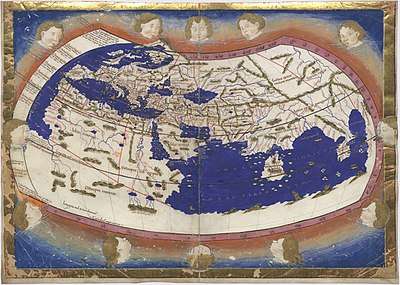Nicolaus Germanus
Nicolaus Germanus (c. 1420 – c. 1490) was a German cartographer who published an edition of Jacopo d'Angelo's Latin translation of Ptolemy's Geography. He also created two globes depicting earth and sky in 1477, predating Martin Behaim's Erdapfel.

Name
Nicolaus Germanus is the Latin form of the name "Nicholas the German". His exact name is unknown, although it is often given with Donis, Donnus, Donmus, or Donus. These are not, however, names but abbreviated forms of the Latin title "Lord" (Dominus).[2]
Life
The exact dates of his birth and death are not known. He is sometimes referred to as a Humanist[1] monk of the Benedictine order[lower-alpha 1] possibly from Reichenbach Priory (now in Baden-Württemberg).[lower-alpha 2] His manuscript edition of Ptolemy was ready by around 1468, but not published until 1482.[1]
Works
In 1477, two years after the opening of the Vatican Library, Nicolaus Germanus created a globe each for earth and sky, for which he was paid 200 ducats on 11 December 1477 according to a receipt.[5] An additional three ducats were paid the next day for the adding of the papal coat of arms, and four more on 20 December for two covers. The globes are listed in an inventory of 1481. The marchesa of Mantua, Isabella, asked for copies in 1505.[lower-alpha 3] The globes were kept in Salle Pontifica (Magna Secreta) until they were lost in the 1527 Sack of Rome. The earth globe of Nicolaus Germanus is considered the first modern globe to be documented.
Nicolaus Germanus's editions of Ptolemy are notable for including four new inset maps showing new European discoveries and for modifying the world map to reflect Italians' better knowledge of Scandinavia[6] following Claudius Clavus's 1424 visit to Italy.[1] Nicolaus Germanus was also the first Western cartographer to publish Ptolemy's more difficult second projection,[lower-alpha 4] in which parallels of latitude are made equidistant but meridians converge toward the poles;[1] it became known in his time as the "Donis Projection".
- Germanus, Nicolaus, ed. (1482), Claudii Ptolomei Viri Alexandrini Cosmographie Octavus et Ultimus Liber Explicit Opus, Ulm: Leinhart Holle. (in Latin)
It was reprinted the same year and again in 1486, with more gold. The 1486 edition is notable as the first atlas to be colored by its publisher prior to sale; uncolored editions are rare.[1] The printing of the world maps in these books was credited to "Johann the Block-cutter" (Johannes Schnitzer) or "Johann from Armsheim" (Johannes de Armssheim), distinctive for his use of a reversed capital ⟨N⟩ (i.e., ⟨И⟩).[6]
Notes
- The Benedictine monk Donnus Nicholas Germanus (fl. 1460-75) was particularly prolific in editing and expanding the Geographia.[3]
- Domnus Nicolaus Germanus, a Benedictine (of Reichenbach?) (1466), was the first scholar who modernized Ptolemy by means of new maps and made him generally accessible. The Benedictine Andreas Walsperger (1448) made a map of the world in the medieval style. That of the Camaldolese Fra Mauro (1457) is the most celebrated of all monuments of medieval cartography. It was already enriched by data furnished in Ptolemy's work. The map of Germany designed by Cardinal Nicholas of Cusa (1401-64), a pupil of Toscanelli (1387-1492), was printed in 1491. This prelate was the teacher of Peuerbach (1432-61), who in turn was the master of Regiomontanus (1436-67), the most illustrious astronomer since Ptolemy.[4]
- Italian: Intendiamo, che ne la libraria dil papa sono due spere solide: In una è depicto el Mapamundo, in l'altra li Signi Celesti, cio è el Zodiaco...
- An earlier Greek cartographer completed one in manuscript for Maximus Planudes c. 1300. It is held in Turkey.[7]
References
Citations
- Suárez (1992).
- "Nicolaus Germanus", Catholic Encyclopedia.
- "Archived copy". Archived from the original on 2007-10-08. Retrieved 2007-10-18.CS1 maint: archived copy as title (link).
- de:Bild:Germanus.jpeg
- "1482: Ulm", James Ford Bell Library, Minneapolis: University of Minnesota, 2001, retrieved 7 August 2016.
- Codex Seragliensis GI 57.
Bibliography
- Babicz, Józef (1987), "The Celestial and Terrestrial Globes of the Vatican Library, Dating from 1477, and their Maker Donnus Nicolaus Germanus (ca 1420 – ca 1490)", Der Globusfreund, pp. 155–168.
- Suárez, Thomas (1992), "6. The Known World", Shedding the Veil: Mapping the European Discovery of America and the New World, Singapore: World Scientific Publishing, p. 24.
External links
| Wikimedia Commons has media related to Donnus Nicolaus Germanus. |
- Cosmographia Claudii Ptolomaei Alexandrini, 1467
- https://web.archive.org/web/20160303183429/http://deposit.ddb.de/online/inkunabel/boe206.htm
- Mitteleuropakarte – Germania tota tabella – von Nicolaus Cusanus in der Redaktion von Nicolaus Germanus, ca. 1478, nach ihrer Inkunabeledition, Eystat 1491.
- Während der letzten Hälfte des 15. Jahrhunderts. fügt der deutsche Mönch Nicolaus Germanus die ersten modernen und korrigierten Landkarten zur Geographie des Ptolemäus hinzu.